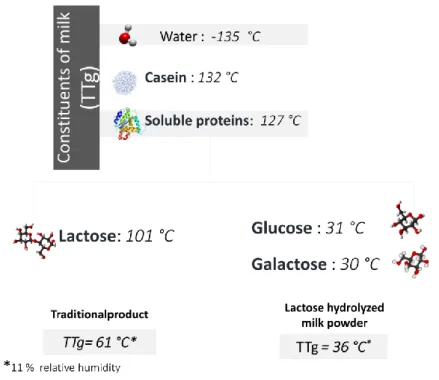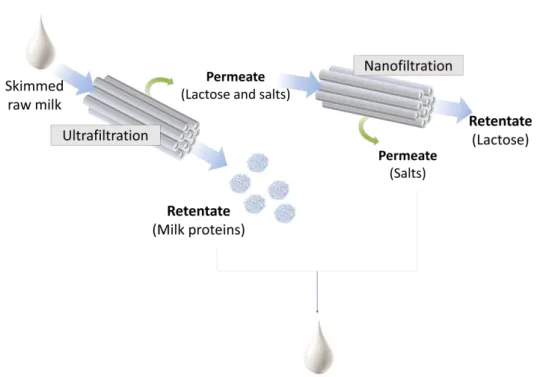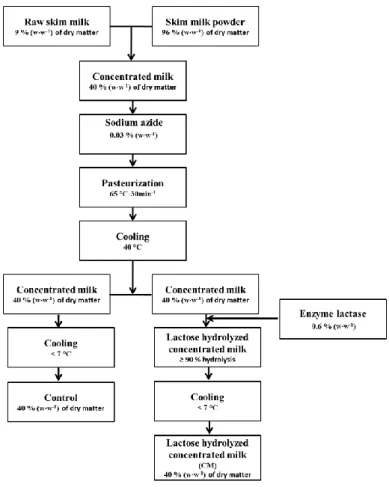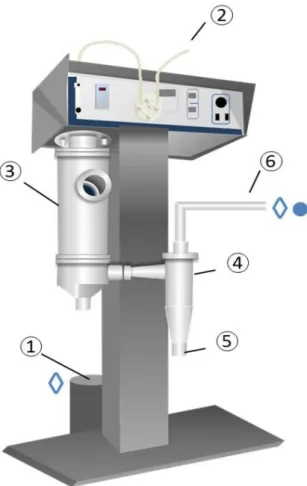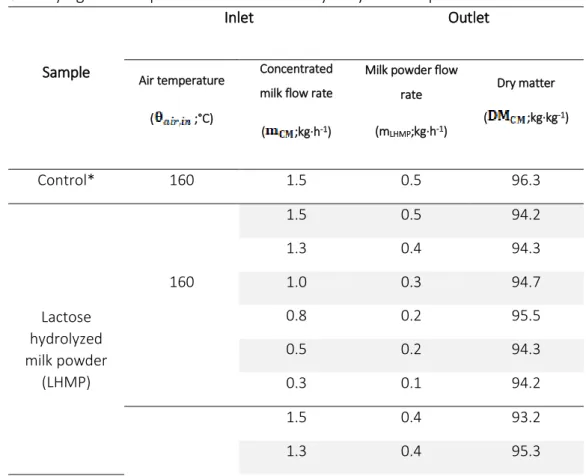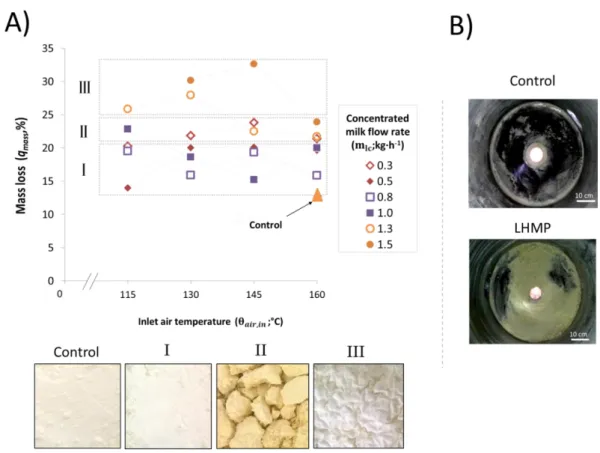Pépite | Poudre de lait hydrolysée au lactose : optimisation du processus de séchage et étude des propriétés structurelles et fonctionnelles
Texte intégral
(2) Thèse de Tatiana Lopes Fialho, Université de Lille, 2019. Université des Sciences et Technologies de Lille Ecole Doctorale des Sciences de la Matière, du Rayonnement et de l’Environnement SMRE Unité Matériaux et Transformations – UMET. THÈSE DE DOCTORAT Thèse soutenue en cotutelle entre l'université des Sciences et Technologies de Lille et Universidade Federal de Viçosa Pour obtenir le degré de:. Docteur de l’université de Lille Spécialité Molécules et Matières condensées Présenté par:. Tatiana LOPES FIALHO POUDRE DE LAIT HYDROLYSÉE AU LACTOSE: OPTIMISATION DU PROCESSUS DE SÉCHAGE ET ÉTUDE DES PROPRIÉTÉS STRUCTURELLES ET FONCTIONNELLES Soutenance de thèse << 20 mai 2019 >> par le comité d'examen. JURY Antônio Fernandes de Carvalho Guillaume Delaplace Ítalo Tuler Perrone Paulo Peres de Sá Peixoto Júnior Francine Fayolle Naaman Francisco Nogueira da Silva Adeline Boire Evandro Martins. © 2019 Tous droits réservés.. Directeur Directeur Co-directeur Co-directeur Rapporteur Président du Jury /Rapporteur Examinateur Examinateur. lilliad.univ-lille.fr.
(3) Thèse de Tatiana Lopes Fialho, Université de Lille, 2019. THESIS OUTPUT Review. Tatiana Lopes Fialho, Pierre Schuck, Evandro Martins, Arlan Caldas Pereira Silveira, Carolina Rodrigues de Jesus Silva, Rodrigo Stephani, Ítalo Tuler Perrone, Antônio Fernandes de Carvalho. (2018). “Leite em pó deslactosado: caracterização termodinâmica do processo e avaliação físico-química e tecno-funcional do produto.” Revista Indústria de laticínios, 132, 129-131.. Tatiana Lopes Fialho, Pierre Schuck, Evandro Martins, Philipe Vasconcellos da Silva, Lauane Nunes, Rodrigo Stephani, Ítalo Tuler Perrone, Antônio Fernandes de Carvalho. (2016). “Desafios na produção de leite em pó deslactosado: breves considerações.” Revista Indústria de Laticínios, 123, 66-67.. Published or Submitted Papers. Tatiana Lopes Fialho, Evandro Martins, Arlan Calds Pereira Silveira, Carolina Rodrigues de Jesus Silva, Ítalo Tuler Perrone, Pierre Schuck, Antônio Fernandes de Carvalho. (2018). “Lactose hydrolyzed milk powder: thermodynamic characterization of the drying process.” Drying Technology, v. 36 (8), 922–931.. Tatiana Lopes Fialho, Evandro Martins, Carolina Rodrigues de Jesus Silva, Rodrigo Stephani, Guilherme Miranda Tavares, Arlan Calds Pereira Silveira, Ítalo Tuler Perrone, Pierre Schuck, Antônio Fernandes de Carvalho. (2018). ‘Lactose hydrolyzed milk powder: physicochemical and techno-functional characterization.’ Drying Technology, 36 (14) 1688-1695.. Tatiana Lopes Fialho, Márcio Henrique Nogueira, Anne Moreau, Guillaume Delaplace, Pierre Schuck, Ítalo Tuler Perrone, Antônio Fernandes de Carvalho, Paulo Peres de Sá Peixoto Júnior. ‘Sugar type matters in spray drying: Homogeneous distribution in milk. ii © 2019 Tous droits réservés.. lilliad.univ-lille.fr.
(4) Thèse de Tatiana Lopes Fialho, Université de Lille, 2019. powder favors repulsive interactions between proteins.’This article was submitted to Food Structure.. Tatiana Lopes Fialho, Anne Moreau, Guillaume Delaplace, Pierre Schuck, Ítalo Tuler Perrone, Claire Roiland, Marc Schumitz, Antônio Fernandes de Carvalho, Paulo Peres de Sá Peixoto Júnior. ‘The molecular mechanism of agglomeration in lactose hydrolyzed milk powder’. This article will be submitted to Food Structure.. Book Chapter. Ítalo Tuler Perrone, Evandro Martins, Tatiana Lopes Fialho, Pierre Schuck, Antônio Fernandes de Carvalho. ‘Lactose hydrolyzed Milk Powder.’ This book chapter will be published in Advances in Spray Drying of Dairy Products.. Oral Presentations. Tatiana Lopes Fialho, Evandro Martins, Paulo Peres de Sá Peixoto Júnios, Guillaume Delaplace, Pierre Schuck, Italo Tuler Perrone, Antônio Fernandes de Carvalho. Journée Jeunes. Chercheurs. GEPROC. –. UGéPE.. (November. 2017).. Caractérisation. thermodynamique du processus de séchage de la poudre de lait hydrolysée. Douai, France.. Tatiana Lopes Fialho, Evandro Martins, Arlan Caldas Pereira Silveira, Carolina Rodrigues de Jesus Silva, Ítalo Tuler Perrone, Pierre Schuck, Antônio Fernandes de Carvalho. Dairy Foods VI: Dairy Ingredients - American Dairy Science Association. (June 2017). Lactose hydrolyzed milk powder: Determination of the optimal drying parameters. Pittsburgh, United States of America.. Poster Presentations. Tatiana Lopes Fialho, Luiz Fernando C. de Oliveira, Rodrigo Stephani, Pierre Schuck, Ítalo Tuler Perrone, Antônio Fernandes de Carvalho. 31° Congresso Nacional de Laticínios. iii © 2019 Tous droits réservés.. lilliad.univ-lille.fr.
(5) Thèse de Tatiana Lopes Fialho, Université de Lille, 2019. (June 2017). Espectroscopia Raman aplicada à produção de leite em pó desnatado deslactosado. Juiz de Fora, Brazil.. Carolina Rodrigues de Jesus Silva, Tatiana Lopes Fialho, Evandro Martins, Ítalo Tuler Perrone, Antônio Fernandes de Carvalho. 31° Congresso Nacional de Laticínios. (June 2017). Influência dos parâmetros operacionais de secagem do leite em pó no desenvolvimento da reação de Maillard. Juiz de Fora, Brazil.. Samyra Veiga Cruz, Tatiana Lopes Fialho, Philipe Vasconcellos da Silva, Evandro Martins, Ítalo Tuler Perrone e Antônio Fernandes de Carvalho. Simpósio Integrado de Inovação em tecnologia de Alimentos. (September 2016). Avaliação físico-química do leite em pó delactosado produzido em diferentes parâmetros de secagem. Viçosa, Brazil.. Philipe Vasconcellos da Silva, Tatiana Lopes Fialho, Evandro Martins, Samyra Veiga Cruz, Ítalo Tuler Perrone e Antônio Fernandes de Carvalho. Simpósio Integrado de Inovação em tecnologia de Alimentos. (September 2016). Estudo da morfologia das partículas do leite em pó delactosado utilizando a microscopia eletrônica de varredura (MEV). Viçosa, Brazil. Best work award of the event.. iv © 2019 Tous droits réservés.. lilliad.univ-lille.fr.
(6) Thèse de Tatiana Lopes Fialho, Université de Lille, 2019. ACKNOWLEDGEMENTS. I would like to express my gratitude to my supervisor, Prof. Antônio Fernandes de Carvalho for his encouragement, support and inspiration throughout these years. I am grateful for his patience, work, help and discussions about both science and life. I would also like to thank my supervisor Professor Guillaume Delaplace for the opportunity to carry out this thesis in Cotutela, and for the reception, trust, support and knowledge he has passed on. I would like to thank my co-advisors Professors Italo T. Perrone, Paulo P. S. P. Júnior for their support and for all their assistance and transfer of knowledge over the years. I would like to thank the Coordenação de Aperfeiçoamento de Pessoal de Nível Superior (CAPES) for the scholarships I received during the exchange and the PhD. I would like to thank all my colleagues in Inovaleite and UFV for the unrestrained help they gave me, for the pleasant and enjoyable moments even on difficult days, for the words of encouragement, and finally, for their friendship. I would like to thank all my colleagues in PIHM for all their assistance, support, attention and confidence. I would like to thank Fernanda, Raul, Ali, Laura, Mavi and Bela for sharing one of the most incredible experiences of my life: my student exchange in France. I would like to thank my big love, Eudes, for support during the hard days and for the wonderful life that we have been able to build together. I would like to express my gratitude to my family for all their love and for believing in me. I would especially like to thank my Grandmother Nina, in memoriam, for her unconditional love and for teaching me the meaning of the word noble. Finally, I would like to thank God for guiding all my steps and allowing me to conquer this stage of my life more fully.. v © 2019 Tous droits réservés.. lilliad.univ-lille.fr.
(7) Thèse de Tatiana Lopes Fialho, Université de Lille, 2019. LIST OF FIGURES Chapter II REVIEW OF LITERATURE Figure 1. Distribution of world population with some degree of lactose intolerance……..8 Figure 2. Diagram of lactose hydrolysis in concentrated milk……………………………………….12 Figure 3. Diagram of production of lactose hydrolyzed milk powder by spray drying.....14 Figure 4. Problems associated with production of lactose hydrolyzed milk powder.......15 Figure 5. Glass transition temperature (TTg) of constituents of milk, traditional milk powder and lactose hydrolyzed milk powder....................................................................17 Figure 6. Diagramof physical removal of lactose of milk by membrane filtration............19 Chapter III OPTIMIZATION OF THE LACTOSE HYDROLYZED MILK POWDER DRYING PROCESS. Part 1: Lactose hydrolyzed milk powder: Thermodynamic characterization of the drying process. Figure 1. Production of the lactose hydrolyzed concentrated milk and concentrated milk (control)..............................................................................................................................29 Figure 2. Spray dryer diagram………………………………………………………………………………………30 Figure 3. Mass loss during lactose hydrolyzed milk powder production (LHMP)................................................................................................................................36 Figure 4. Effect of operational parameters on the energy balance for lactose hydrolyzed milk powder production.....................................................................................................41 Part 2: Lactose hydrolyzed milk powder: Physicochemical and techno-functional characterization. Figure 1. Production of lactose hydrolyzed concentrated milk and concentrated milk (control)..............................................................................................................................52 Figure 2. Effect of lactose hydrolyzed milk powder drying parameters...........................58 Figure 3. Scanning electron microscopy of lactose hydrolyzed milk powders produced under different drying conditions......................................................................................59 vi © 2019 Tous droits réservés.. lilliad.univ-lille.fr.
(8) Thèse de Tatiana Lopes Fialho, Université de Lille, 2019. Chapter IV STRUCTURAL AND FUNCTIONAL PROPERTIES OF LACTOSE HYDROLYZED MILK POWDER. Part 1: Sugar type matters in spray drying: Homogeneous distribution in milk powder favors repulsive interactions between proteins. Figure 1. Spray drying water loss: traditional concentrated milk vs. lactose hydrolyzed concentrated milk..............................................................................................................72 Figure 2. SEM micrographs of traditional milk powder (left) and lactose hydrolyzed milk powder (right) ……………………………………………………………………………………………………………..74 Figure 3. 1H NMR quantitative spectra of traditional milk powder (blue) and lactose hydrolyzed milk powder (red) samples..............................................................................76 Figure 4. Rehydration kinetics of the traditional milk powder (blue) and the lactose hydrolyzed milk powder (red) samples..............................................................................78 Figure 5. Diagram of traditional milk powder (A) and lactose hydrolyzed milk powder (B) particle molecular organizations…………………………………………………………………………………..79. Part 2: The molecular mechanism of agglomeration in lactose hydrolyzed milk powder. Figure 1. Browning index of traditional milk powder (blue line) and lactose hydrolyzed milk powder (orange line) in aging time............................................................................91 Figure 2. SEM micrographs of the powders......................................................................93 Figure 3. Electrophoretic profile of the powders..............................................................95 Figure 4. Saxs profile of the powders……………………………………………………………………………97 SUPPLEMENTARY MATERIAL. Part 1: Sugar type matters in spray drying: Homogeneous distribution in milk powder favors repulsive interactions between proteins. Figure 1. SAXS profil (A) and electrophoretic profile (B) of casein micelles from the traditional milk powder and the lactose hydrolyzed milk powder samples...................113. vii © 2019 Tous droits réservés.. lilliad.univ-lille.fr.
(9) Thèse de Tatiana Lopes Fialho, Université de Lille, 2019. LIST OF TABLES Chapter II REVIEW OF LITERATURE. Table 1. Microbial source of β-D-galactosidase enzymes.................................................10 Chapter III OPTIMIZATION OF THE DRYING PROCESS OF LACTOSE HYDROLYZED MILK POWDER. Part 1: Lactose hydrolyzed milk powder: Thermodynamic characterization of the drying process. Table 1. Drying data for the production of lactose hydrolyzedd milk powder.................34 Table 2: Data obtained for energy balance calculations...................................................39 Part 2: Lactose hydrolyzed milk powder: Physicochemical and techno-functional characterizations. Table 1. Drying settings………………………………………………………………………………………………..55 Table 2. Particle size distribution (% volume)………………………...........................................61 Chapter IV STRUCTURAL AND FUNCTIONAL PROPERTIES OF LACTOSE HYDROLYZED MILK POWDER. Part 1: Sugar type matters in spray drying: Homogeneous distribution in milk powder favors repulsive interactions between proteins. Table 1. Longitudinal relaxation time 1H (T1) of milk proteins………………………………………77. Part 2: The molecular mechanism of agglomeration in lactose hydrolyzed milk powder. viii © 2019 Tous droits réservés.. lilliad.univ-lille.fr.
(10) Thèse de Tatiana Lopes Fialho, Université de Lille, 2019. Table 1. D90 value relative to the diameter of the particles (μm) of the traditional milk powder and lactose hydrolyzed over the course of aging................................................94 Chapter V CONCLUSION & PERSPECTIVES. Table 1. Influence of drying parameters on the process and powder characteristics...105 Table 2. Comparison of lactose hydrolyzed milk powder (Inlet air temperature at 145 °C and concentrated milk flow rate at 1.0 kg∙h-1) and traditional milk powder (control) ..106 Table 3. Accelerated aging of lactose hydrolyzed milk powder......................................107 SUPPLEMENTARY MATERIALS. Part 1: Sugar type matters in spray drying: Homogeneous distribution in milk powder favors repulsive interactions between proteins. Table 1. Osmotic pressure of traditional concentrated milk solutions after stabilization......................................................................................................................111 Table 2: Osmotic pressure of lactose hydrolyzed concentrated milk solution after stabilization………………………………………………………………………………………………………………..111 Table 3: Osmotic pressure of polyethylene glycol solution after stabilization…………….112. ix © 2019 Tous droits réservés.. lilliad.univ-lille.fr.
(11) Thèse de Tatiana Lopes Fialho, Université de Lille, 2019. ABSTRACT FIALHO, Tatiana Lopes, D.Sc., Thesis supported in cotutelle between the Université des Sciences et Technologies de Lille and the Universidade Federal de Viçosa, May, 2019. Lactose hydrolyzed milk powder: Optimization of the drying process and study of structural and functional properties. Advisor: Antônio Fernandes de Carvalho. Co-advisors: Italo Tuler Perrone, Pierre Schuck and Evandro Martins. The production technology of lactose hydrolyzed milk powder has been developed to meet the needs of lactose intolerant consumers. Although the product is currently marketed in some countries, the industry faces technological issues during the production and storage of the powder such as agglomeration, caking, browning, high hygroscopicity, low production yield and loss of techno-functional properties. In this context, two main objectives were assigned to the work of this thesis: (i) to optimize the drying process of lactose hydrolyzed milk powder; (ii) to understand the impact of lactose hydrolysis on the internal structure of lactose hydrolyzed milk powder on a molecular scale. In order to optimize the drying process of lactose hydrolyzed milk powder, powder samples were subjected to various drying conditions: concentrated milk flow rates varying from 0.3 to 1.5 kg∙h-1 and inlet air temperature ranging from 115 to 160 °C. Then, a thermodynamic characterization of the drying process was carried out using the equations of mass and energy balance. To understand the impact of lactose hydrolysis on the internal structure of the powder after drying and during storage, the organization and dynamics of the molecules in lactose hydrolyzed milk powder were analyzed by examining appearance and structure of the powder samples and their techno-functional properties. Throughout the experiments, traditional milk powder was used as a control. In this study, it has been observed that the ideal parameters for lactose hydrolyzed milk powder production were: inlet air temperature at 145 ° C and 1.0 kg ∙ h-1 flow rate. This finding reinforces the idea that the drying conditions of lactose hydrolyzed milk powder are different from those used to make traditional milk powder. It was also observed that molecules present in milk powder hydrolyzed with lactose presented a more homogeneous molecular organization compared to traditional milk powder and allowed for greater protein-sugar interaction. Under accelerated aging conditions of the hydrolyzed powder, the protein glycation was x © 2019 Tous droits réservés.. lilliad.univ-lille.fr.
(12) Thèse de Tatiana Lopes Fialho, Université de Lille, 2019. the initial process that triggers the main modifications observed in lactose hydrolyzed milk powder during storage.. xi © 2019 Tous droits réservés.. lilliad.univ-lille.fr.
(13) Thèse de Tatiana Lopes Fialho, Université de Lille, 2019. RESUMO FIALHO, Tatiana Lopes, D.Sc., Tese em cotutela entre l'université des Sciences et Technologies de Lille e Universidade Federal de Viçosa, maio de 2019. Leite em pó com lactose hidrolisada: Otimização do processo de secagem e estudo das propriedades estruturais e funcionais. Orientador: Antônio Fernandes de Carvalho. Coorientadores: Ítalo Tuler Perrone, Pierre Schuck e Evandro Martins. A tecnologia de produção de leite em pó hidrolisado com lactose foi desenvolvida para atender às necessidades dos consumidores intolerantes à lactose. Embora o produto seja atualmente comercializado em alguns países, a indústria enfrenta problemas tecnológicos durante a produção e armazenamento do pó, como aglomeração, aglomeração, escurecimento, alta higroscopicidade, baixo rendimento de produção e perda de propriedades tecnofuncionais. Neste contexto, dois objetivos principais foram atribuídos ao trabalho desta tese: (i) otimizar o processo de secagem do leite em pó hidrolisado com lactose; (ii) compreender o impacto da hidrólise da lactose na estrutura interna do leite em pó hidrolisado à base de lactose em escala molecular. Para otimizar o processo de secagem do leite em pó hidrolisado com lactose, as amostras de pó foram submetidas a diferentes condições de secagem: fluxo de leite concentrado variando de 0,3 a 1,5 kg h-1 e temperatura do ar de entrada variando de 115 a 160 ° C. Em seguida, uma caracterização termodinâmica do processo de secagem foi realizada utilizando as equações de massa e balanço de energia. Para compreender o impacto da hidrólise da lactose sobre a estrutura interna do pó após a secagem e durante o armazenamento, analisou-se a organização e dinâmica das moléculas em leite em pó hidrolisado pela análise do aspecto e estrutura das amostras de pó e suas propriedades tecno-funcionais. Ao longo dos experimentos, o leite em pó tradicional foi usado como controle. Neste estudo, observou-se que os parâmetros ideais para a produção de leite em pó hidrolisado com lactose foram: temperatura do ar de entrada a 145 ° C e vazão de 1,0 kg∙h-1. Este achado reforça a ideia de que as condições de secagem do leite em pó hidrolisado à base de lactose são diferentes daquelas usadas para fazer o leite em pó tradicional. Observou-se também que as moléculas presentes no leite em pó hidrolisado com lactose apresentaram uma organização molecular mais homogênea em relação ao leite em pó tradicional e permitiram maior interação proteína-açúcar. Em condições de envelhecimento acelerado do pó hidrolisado, a glicação da proteína foi o xii © 2019 Tous droits réservés.. lilliad.univ-lille.fr.
(14) Thèse de Tatiana Lopes Fialho, Université de Lille, 2019. processo inicial que desencadeou as principais modificações observadas no leite em pó hidrolisado de lactose durante o armazenamento.. xiii © 2019 Tous droits réservés.. lilliad.univ-lille.fr.
(15) Thèse de Tatiana Lopes Fialho, Université de Lille, 2019. RÉSUMÉ FIALHO, Tatiana Lopes, D.Sc., Thèse soutenue en cotutelle entre l'université des Sciences et Technologies de Lille et Universidade Federal de Viçosa, Mai, 2019. Lait hydrolysé au lactose: Optimisation du processus de séchage et étude des propriétés structurelles et fonctionnelles. Directeur: Antônio Fernandes de Carvalho. Co-directeur: Italo Tuler Perrone, Pierre Schuck and Evandro Martins. La technologie de production de la poudre de lait hydrolysée au lactose a été développée pour répondre aux besoins des consommateurs intolérants au lactose. Bien que le produit soit actuellement commercialisé dans certains pays, le secteur est confronté à des problèmes technologiques lors de la production et du stockage de la poudre, tels que l'agglomération, la prise en masse, le brunissement, une hygroscopicité élevée, un faible rendement de production et une perte de propriétés techno-fonctionnelles. Dans ce contexte, deux objectifs principaux ont été assignés aux travaux de cette thèse: (i) optimiser le processus de séchage de la poudre de lait hydrolysée au lactose; (ii) comprendre l'impact de l'hydrolyse du lactose sur la structure interne de la poudre de lait hydrolysée au lactose à l'échelle moléculaire. Afin d'optimiser le processus de séchage de la poudre de lait hydrolysée au lactose, des échantillons de poudre ont été soumis à différentes conditions de séchage: débits de lait concentré variant de 0,3 à 1,5 kg∙h-1 et température d'entrée de l'air comprise entre 115 et 160°C. Ensuite, une caractérisation thermodynamique du processus de séchage a été réalisée en utilisant les équations de bilan massique et énergétique. Pour comprendre l'impact de l'hydrolyse du lactose sur la structure interne de la poudre après séchage et pendant le stockage, nous avons analysé l'organisation et la dynamique des molécules dans la poudre de lait hydrolysée au lactose en examinant l'aspect et la structure des échantillons de poudre et leurs propriétés technofonctionnelles. Tout au long des expériences, le lait en poudre traditionnel a été utilisé comme témoin. Dans cette étude, il a été observé que les paramètres idéaux pour la production de la poudre de lait hydrolysée au lactose étaient les suivants: température de l'air entrant à 145°C et débit de 1,0 kg∙h-1. Cette découverte renforce l'idée selon laquelle les conditions de séchage de la poudre de lait hydrolysée au lactose sont différentes de celles utilisées pour la fabrication de la poudre de lait traditionnel. Il a xiv © 2019 Tous droits réservés.. lilliad.univ-lille.fr.
(16) Thèse de Tatiana Lopes Fialho, Université de Lille, 2019. également été observé que les molécules présentes dans la poudre de lait hydrolysée au lactose présentaient une organisation moléculaire plus homogène par rapport la poudre de lait traditionnel et permettaient une plus grande interaction protéine-sucre. Dans des conditions de vieillissement accéléré de la poudre hydrolysée, la glycation des protéines était le processus initial qui a déclenché les principales modifications observées dans la poudre de lait hydrolysée au lactose pendant le stockage.. xv © 2019 Tous droits réservés.. lilliad.univ-lille.fr.
(17) Thèse de Tatiana Lopes Fialho, Université de Lille, 2019. SUMMARY Chapter I INTRODUCTION 1. Context of the project ...................................................................................................2 2. Objectives........................................................................................................................3 3. Manuscript organization.................................................................................................3 4. References.......................................................................................................................4. Chapter II REVIEW OF LITERATURE. 1. Introduction.....................................................................................................................8 2. Enzymatic lactose hydrolysis in milk...............................................................................9 3. Spray drying of concentrated milk with hydrolyzed lactose........................................12 4. Problems associated with production of lactose hydrolyzed milk powder.................14 5. Perspectives on the production of lactose hydrolyzed milk powder...........................18 6. References.....................................................................................................................19. Chapter III OPTIMIZATION OF THE LACTOSE HYDROLYZED MILK POWDER DRYING PROCESS. Part 1: Lactose hydrolyzed Milk Powder: Thermodynamic Characterization of the Drying Process. Preamble............................................................................................................................25 Abstract..............................................................................................................................26 1. Introduction...................................................................................................................26 2. Materials and Methods.................................................................................................28 xvi © 2019 Tous droits réservés.. lilliad.univ-lille.fr.
(18) Thèse de Tatiana Lopes Fialho, Université de Lille, 2019. 2.1. Materials.................................................................................................................28 2.2. Production of lactose hydrolyzed concentrated milk...........................................28 2.3. Production of lactose hydrolyzed milk powder (LHMP)........................................29 2.4. Thermodynamic characterization of the drying process......................................31 2.4.1. Mass balance...................................................................................................31 2.4.2. Energy balance................................................................................................31 2.5. Powder analyses.....................................................................................................32 2.5.1. Moisture content and dry matter...................................................................33 2.5.2. Water activity (aw)...........................................................................................33 2.5.3. Glass transition temperature (Ttg).................................................................33 2.5.4. Quantification of the 5-hydroxymethylfurfural (HMF)..................................33 2.5.5. Statistical analysis...........................................................................................33 3. Results and discussion...................................................................................................33 3.1. Evaluation of mass loss..........................................................................................34 3.2. Evaluation of energy loss.......................................................................................38 3.3. Ideal operational parameters to produce lactose hydrolyzed milk powder.........43 4. Conclusion.....................................................................................................................44 5. References.....................................................................................................................44. Part 2: Lactose hydrolyzed milk Powder: physicochemical and techno-functionall Characterization Preamble............................................................................................................................48 Abstract..............................................................................................................................49 1. Introduction...................................................................................................................50 2. Material and Methods...................................................................................................51 2.1. Material..................................................................................................................51 2.2. Production of lactose hydrolyzed concentrated milk...........................................51 2.3. Production of lactose hydrolyzed milk powder (LHMP)........................................52 2.4. Powder analyses.....................................................................................................53 2.4.1. Moisture content and dry matter...................................................................53 2.4.2. Water activity (aw)...........................................................................................53 2.4.3. Colorimetry analyses.......................................................................................53 2.4.4. Quantification of the 5-hydroxymetylfurfural free (HMF).............................53 2.4.5. Scanning eletronic microscopy (SEM)............................................................54 2.4.6. Particle size analysis by laser diffraction........................................................54 3. Results and discussion...................................................................................................54 xvii © 2019 Tous droits réservés.. lilliad.univ-lille.fr.
(19) Thèse de Tatiana Lopes Fialho, Université de Lille, 2019. 3.1. Physicochemical of lactose hydrolyzed milk powders..........................................56 3.2. Techno-functional properties of lactose hydrolyzed milk powders.....................58 4. Conclusion.....................................................................................................................61 5. References.....................................................................................................................61. Chapter IV STRUCTURAL AND FUNCTIONAL PROPERTIES OF LACTOSE HYDROLYZED MILK POWDER. Part 1: Sugar type matters in spray drying: homogeneous distribution in milk powder favors repulsive interactions between proteins. Preamble............................................................................................................................67 Abstract..............................................................................................................................68 1. Introduction...................................................................................................................68 2. Material and methods..................................................................................................70 2.1. Production of milk powder....................................................................................70 2.2. Powder analyses.....................................................................................................70 2.2.1. Simulation of the drying process....................................................................70 2.2.2. Water activity (aw)...........................................................................................71 2.2.3. Moisture content............................................................................................71 2.2.4. Scanning Electron Microscopy (SEM).............................................................71 2.2.5. Nuclear magnetic resonance (NMR)..............................................................71 2.2.6. Total rehydration time....................................................................................72 3. Results and discussion...................................................................................................72 3.1. Impact of lactose hydrolysis on the osmotic pressure of concentrated milk.......72 3.2. Impact of lactose hydrolysis on milk powder particles.........................................74 3.2.1. Particle microstructure...................................................................................74 3.2.2. Molecular organization of saccharides and protein dynamics......................76 3.2.3. Rehydration kinetics.......................................................................................78 3.3. Particle molecular organization.............................................................................79 4. Conclusion.....................................................................................................................80 5. References.....................................................................................................................80. Part 2: The molecular mechanism of agglomeration in lactose hydrolyzed milk powder. xviii © 2019 Tous droits réservés.. lilliad.univ-lille.fr.
(20) Thèse de Tatiana Lopes Fialho, Université de Lille, 2019. Preamble............................................................................................................................85 Abstract..............................................................................................................................86 1. Introduction...................................................................................................................86 2. Materials and methods.................................................................................................88 2.1. Production of lactose hydrolyzed concentrated milk...........................................88 2.2. Production of lactose hydrolyzed milk powder.....................................................88 2.3. Aging of the powder...............................................................................................89 2.4. Powder analysis......................................................................................................89 2.4.1. Browning index determination.......................................................................89 2.4.2. Scanning electron microscopy (SEM).............................................................89 2.4.3. Total rehydration time....................................................................................89 2.4.4. Electrophoretic separation.............................................................................90 2.4.5. Small-angle x-ray scattering (SAXS)................................................................90 3. Results and discussion...................................................................................................91 3.1. Aspects of powder particles...................................................................................91 3.1.1. Color................................................................................................................91 3.1.2. Microstructure................................................................................................92 3.2. Aspect of molecular structure...............................................................................93 3.2.1. Rehydration kinects and micelle size..............................................................93 3.2.2. Covalent links measurement..........................................................................95 3.2.3. Internal molecular organization of micelles after rehydration......................96 4. Conclusion.....................................................................................................................98 5. References.....................................................................................................................98. Chapter V CONCLUSION & PERSPECTIVES. 1. Conclusion...................................................................................................................105 2. Perspectives.................................................................................................................107 2.1. Optimization of industrial spray dryer drying parameters..................................108 2.2. Mapping the composition of lactose hydrolyzed milk powder...........................108 2.3. Study of the impact of lactose hydrolysis on the molecular organization of lactose hydrolyzed whole milk powder..................................................................108 2.4. Study of the stability of lactose hydrolyzed milk powder during the shelf life...108. xix © 2019 Tous droits réservés.. lilliad.univ-lille.fr.
(21) Thèse de Tatiana Lopes Fialho, Université de Lille, 2019. SUPPLEMENTARY MATERIALS. Part 1: Sugar type matters in spray drying: homogeneous distribution in milk powder favors repulsive interactions between proteins 1. Mathematical description of osmotic pressure..........................................................110 1.1. Materials and methods........................................................................................110 1.1.1. Theoretical osmotic pressure.......................................................................110 1.1.2. Experimental osmotic pressure....................................................................110 1.2. Results..................................................................................................................110 1.2.1. Calculated theoretical osmotic pressure......................................................110 1.2.2. Experimental osmotic pressure....................................................................111 2. Proteins do not display any strutural differences between samples.........................112 2.1. Materials and methods........................................................................................112 2.1.1. Small-angle x-ray scattering (SAXS)..............................................................112 2.1.2. Electrophoretic separation...........................................................................112 2.2. Result....................................................................................................................113 3. References...................................................................................................................114. xx © 2019 Tous droits réservés.. lilliad.univ-lille.fr.
(22) Thèse de Tatiana Lopes Fialho, Université de Lille, 2019. CHAPTER I INTRODUCTION. 1 © 2019 Tous droits réservés.. lilliad.univ-lille.fr.
(23) Thèse de Tatiana Lopes Fialho, Université de Lille, 2019. 1. Context of the project Drying milk is the most commonly used method in the dehydrated dairy manufacturing sector because it extends storage and conservation time while reducing logistics costs and nutritional losses (Schuck et al., 2005). Lactose is the most abundant component in milk and skimmed milk powders, 38% and 51%, respectively (Marconi & Panfili, 1998; Schuck et al., 2005). The disaccharide is made up of glucose and galactose, two monosaccharides covalently linked by a β-glycosidic bond (1-4) (Walstra, Wousters, & Geurts, 2006). Lactose intolerance is one dietary issue related to the consumption of foods with high lactose contents. Recent research has demonstrated that 75% of the world population show some degree of lactose intolerance (Silva, Oliveira, & Perin, 2019), with a higher concentration of lactose intolerant individuals in South America, Africa and Asia (Lule et al., 2016). In order to meet demand from the lactose-intolerant populations, a wide variety of lactose-free dairy products are now available on the market, such as pasteurized and UHT milk, yogurt, cheeses, ice-cream, dulce de leche and others dairy products (Abbasi & Saeedabadian, 2013; Antunes et al., 2014; Mota, et al., 2009; Ruiz-Matute et al., 2012; Vénica et al., 2013). The production technology for milk powder with low lactose content has been developed quite recent and most of the current industrial processes are based on the enzymatic hydrolysis of this sugar. Although lactose hydrolyzed milk powder is already marketed in some countries, the industry faces several technological drawbacks during production and storage, such as agglomeration, stickiness, caking, browning and elevated hygroscopicity. All of these result in low production yield and loss of technofunctional properties (Fialho et al., 2018; Fialho et al., 2018; Torres et al., 2017). Currently, few reports have been dedicated to explaining the issues related to he production of lactose hydrolyzed milk powder; nevertheless, existing works designate the glass transition as a key to the problem (Fernández, Schebor & Chirife, 2003; Shrestha et al., 2007; Torres et al., 2017). The glass transition (Tg) consists of a change of the system from a glassy state (high viscosity fluid) to a rubbery state (low viscosity fluid) when the dairy powder particles are heated to the glass transition temperature (TTg). The rubbery state leads to structural changes in the powder and results in a 2 © 2019 Tous droits réservés.. lilliad.univ-lille.fr.
(24) Thèse de Tatiana Lopes Fialho, Université de Lille, 2019. product with undesirable physicochemical characteristics (Roos, 2002; Schuck et al., 2005). The glass transition temperature (TTg) of dairy powders is linked to the concentration, specific heat, and glass transition temperature of each component. Since water has a low glass transition temperature (TTg= -135°C), this constituent is the principal component responsible for decreasing the glass transition temperature of dairy powder (Roos & Drusch, 2015). In the case of lactose hydrolyzed milk powder, lactose (TTg=101°C) is hydrolyzed into glucose (TTg= 31°C) and galactose (TTg= 30°C) (Roos, 1993; Roos & Karel, 1990). As a consequence of carbohydrate hydrolysis, the glass transition temperature of lactose hydrolyzed milk powder (36°C when in equilibrium with air containing 11% relative humidity) is significantly lower than that of traditional milk powder (61°C under the same equilibrated conditions) (Fernández, Schebor, & Chirife, 2003). Because of this drop in TTg, lactose hydrolyzed milk powder is more prone to a glass transition during drying, transport and storage.. 2. Objectives In this context, two main objectives were assigned to this study: (i) to optimize the drying process of lactose hydrolyzed milk powder; (ii) to understand the impact of lactose hydrolysis on a product’s internal structure at a molecular scale.. 3. Manuscript organization This document is divided into the following chapters: -. Chapter II: Review of literature. This section presents a compilation of studies that show the importance of lactose hydrolyzed milk powder production around the world, the principles that govern this production, the technological problems associated with it, and the challenges the market faces to produce lactose hydrolyzed milk powder. This section will be published as a chapter entitled "Lactose hydrolyzed milk powder" in Advances in Spray Drying of Dairy Products.. -. Chapter III: Optimization of the lactose hydrolyzed milk powder drying process. This chapter seeks to understand drying process characteristics and powder 3. © 2019 Tous droits réservés.. lilliad.univ-lille.fr.
(25) Thèse de Tatiana Lopes Fialho, Université de Lille, 2019. quality with various drying parameters. The first section focuses on a thermodynamic study of the process and explores different inlet air temperatures and concentrated milk flow rates. The second section evaluates the product’s physicochemical and techno-functional characteristics when subjected to inlet air and concentrated milk flow rate variations. These two sections haves been published in Drying Technology (Fialho et al., 2018).. -. Chapter IV: Study of the structural and functional properties of lactose hydrolyzed milk powder. This section explores the impact of sugars (lactose, galactose and glucose) on the molecular structure of lactose hydrolyzed milk powder. The first part focuses on sugar-sugar and sugar-protein interactions and how they affect the powder’s molecular organization. This first part was submitted to Food Structure. The second part describes the molecular mechanism of agglomeration in lactose hydrolyzed milk powder.’ This second part will be submitted to Food Structure.. -. Chapter V: Conclusion and perspectives. This section indicates future areas of study to continue to build on the research presented.. 4. References Abbasi, S., & Saeedabadian, A. (2013). ‘Influences of lactose hydrolysis of milk and sugar reduction on some physical properties of ice cream.’ Journal of Food Science and Technology, (2003). https://doi.org/10.1007/s13197-013-1011-1 Antunes, A. E. C., Alves, A. T. S., Gallina, D. A., Trento, F. K. H. S., & Zacarchenco, P. B. (2014). ‘Development and shelf-life determination of pasteurized, microfiltered, lactose hydrolyzed. skim. milk.’. Journal. of. Dairy. Science,. 97(9),. 5337–5344.. https://doi.org/10.3168/jds.2014-8020 Fernández, E., Schebor, C., & Chirife, J. (2003). ‘Glass transition temperature of regular and lactose hydrolyzed milk powders.’ LWT - Food Science and Technology, 36(5), 547– 551. https://doi.org/10.1016/S0023-6438(03)00022-7. 4 © 2019 Tous droits réservés.. lilliad.univ-lille.fr.
(26) Thèse de Tatiana Lopes Fialho, Université de Lille, 2019. Fialho, T. L., Martins, E., Silva, C. R. J., Stephani, R., Tavares, G., Silveira, A. C. P., Perrone, I. T., Schuck, P., Oliveira, L. F. C., Carvalho, A. F. (2018). ‘Lactose hydrolyzed milk powder: Physicochemical and techno-functional characterization.’ Drying Technology, 36(14), 1688–1695. https://doi.org/10.1080/07373937.2017.1365725 Fialho, T. L., Martisn, E., Silveira, A. C. P., Silva, C. R. J., Perrone, I. T., Schuck, P., & Carvalho, A. F. (2018). Lactose hydrolyzed milk powder : ‘Thermodynamic characterization of the drying process.’ Drying Technology, 36(8), 922–931. https://doi.org/10.1080/07373937.2017.1365725 Lule, V. K., Garg, S., Tomar, S. K., & Dairy, N. (2016). ‘Food Intolerance : Lactose Intolerance.’. Encyclopedia. of. Food. and. Health. (1st. ed.).. Elsevier. Ltd.. https://doi.org/10.1016/B978-0-12-384947-2.00312-3 Marconi, E., & Panfili, G. (1998). ‘Chemical Composition and Nutritional Properties of Commercial Products of Mare Milk Powder.’ Journal of Food Composition and Analysis, 11(2), 178–187. https://doi.org/10.1006/jfca.1998.0573 Mota, K., Moreira, M., Coelho, L. H., Perini, C. C., & Karam, L. B. (2009). ‘Produção de doce de leite com teor reduzido de lactose por beta-galactosidase.’ Rev. Acad., Ciênc. Agrár. Ambient., 7(4), 375–382. Ruiz-Matute, A. I., Corzo-Martínez, M., Montilla, A., Olano, A., Copovi, P., & Corzo, N. (2012). ‘Presence of mono-, di- and galactooligosaccharides in commercial lactose-free UHT dairy products.’ Journal of Food Composition and Analysis, 28(2), 164–169. https://doi.org/10.1016/j.jfca.2012.06.003 Schuck, P., Blanchard, E., Dolivet, A., Méjean, S., Onillon, E., Schuck, P., … Onillon, E. (2005a). ‘Water activity and glass transition in dairy ingredients.’ Lait, 85, 295–304. https://doi.org/10.1051/lait Shrestha, A. K., Howes, T., Adhikari, B. P., & Bhandari, B. R. (2007). ‘Water sorption and glass transition properties of spray dried lactose hydrolysed skim milk powder.’ LWT Food. Science. and. Technology,. 40,. 1593–1600.. https://doi.org/10.1016/j.lwt.2006.11.003. 5 © 2019 Tous droits réservés.. lilliad.univ-lille.fr.
(27) Thèse de Tatiana Lopes Fialho, Université de Lille, 2019. Silva, P. H. F., Oliveira, V. C. D., & Perin, L. M. (2019). ‘Cow’s Milk Protein Allergy and Lactose. Intolerance.’. Raw. Milk. (pp.. 295–309).. Elsevier. Inc.. https://doi.org/10.1016/B978-0-12-810530-6.00014-6 Torres, J. K. F., Stephani, R., Tavares, G. M., Carvalho, A. F., Costa, R. G. B., Almeida, C. E. R., Almeida, M. R., Oliveira, L. F. C., Schuck, P., Perrone, I. T. (2017a). ‘Technological aspects of lactose hydrolyzed milk powder.’ Food Research International, 101(August), 45–53. https://doi.org/10.1016/j.foodres.2017.08.043 Vénica, C. L., Bergamini, C. V., Zalazar, C. A., & Perotti, M. C. (2013). ‘Effect of Lactose Hydrolysis during Manufacture and Storage of Drinkable Yogurt.’ Journal of Food & Nutrotional Disorders, 2, 1–7. Walstra, P., Wousters, J. T. M., & Geurts, T. J. (2006). FOOD SCIENCE AND TECHNOLOGY. (2° Ed.) (Taylor and). New York.. 6 © 2019 Tous droits réservés.. lilliad.univ-lille.fr.
(28) Thèse de Tatiana Lopes Fialho, Université de Lille, 2019. CHAPTER II REVIEW OF LITERATURE. 7 © 2019 Tous droits réservés.. lilliad.univ-lille.fr.
(29) Thèse de Tatiana Lopes Fialho, Université de Lille, 2019. Lactose hydrolyzed milk powder The content of this second chapter will be published in book: Advances in Spray Drying of Dairy Products. Evandro Martins, Tatiana Lopes Fialho, Pierre Schuck, Antônio Fernandes de Carvalho, Ítalo Tuler Perrone. 1. Introduction Recent surveys estimate that 75% of world population show some degree of lactose intolerance (Silva et al., 2019). Although this food sensitivity is widespread around the world, there are higher numbers of lactose-intolerant individuals in South America, Africa and Asia. Lactose intolerance can limit the consommation of dairy products in these regions (Lule et al., 2016)(Figure 1).. Figure 1. Distribution of world population with some degree of lactose intolerance. Adapted from Valio (2018): https://www.valio.com/consumers/lactose-free/. 8 © 2019 Tous droits réservés.. lilliad.univ-lille.fr.
(30) Thèse de Tatiana Lopes Fialho, Université de Lille, 2019. Lactose intolerance in humans is characterized by the absence or the low production of the β-D-galactosidase enzyme, commonly known as lactase, which hydrolyzes lactose to release galactose and glucose monosaccharides for bloodstream absorption (Gerbault et al., 2011). Inefficient enzymatic hydrolysis of lactose allows the to sugar arrive intact in the intestinal lumen. This increases local osmolarity and also serves as a substrate for gut microbiota that can then produce acids and gases as CH4, CO2 and H2 (Lule et al., 2016). The most common clinical consequences of low lactose digestion in lactose intolerant individuals are diarrhea, flatulence and abdominal distension (Gerbault et al., 2011). About 5.7 billion people around the world are potential consumers of lowlactose dairy products, which represents a large market segment. According to the latest report published by Future Market Insights, the global lactose-free dairy products market is estimated to reach US$ 17.8 million by the end of 2027. This estimative has driven new product development in the dairy industry (Report, 2018). A wide variety of lactose-free dairy products are available on the market. These include pasteurized and UHT milk, yogurt, cheeses, ice-cream, and dulce de leche (Abbasi & Saeedabadian, 2013; Antunes et al., 2014; Mota et al., 2009; Ruiz-Matute et al., 2012; Vénica et al., 2013). The technology for producing milk powder with low lactose content is quite recent. Most of the current industrial processes are based on the enzymatic hydrolysis of the sugar. Although this product is already marketed in some countries, the dairy industry faces certain technological drawbacks in using it, such as as low production yield, equipment operation malfunctions, and powder adhesion to the drying tower, plus problems associated with the loss of techno-functional properties during powder storage (Fialho et al., 2018; Fialho et al., 2018; Torres et al., 2017). In this chapter, the primary techniques for producing lactose hydrolyzed milk powder will be covered. The production challenges and the strategies that can be adopted to overcome them will be emphasized.. 2. Enzymatic lactose hydrolysis in milk The first study involving lactose hydrolysis in raw and pasteurized milks by application of lactase from Saccharomyces lactis was published in 1973 (Kosikowski & 9 © 2019 Tous droits réservés.. lilliad.univ-lille.fr.
(31) Thèse de Tatiana Lopes Fialho, Université de Lille, 2019. Wierbicki, 1973). 18 years later, a patent was registered for the process which uses a sonicated culture medium containing bacterial cells as a source of lactase to produce milk and dairy products with hydrolyzed lactose (Jackson & Jelen, 1989). β-D-galactosidase is isolated from different sources such as plants (almonds, peaches, apricots, apples), animal organs, yeasts, bacteria and filamentous fungi (Richmond, Gray, & Stine, 1981). Current enzymes produced from bacteria, yeasts or filamentous fungi are more frequently used in foods and can be commercially acquired in powder or liquid form (Table 1).. Table 1. Microbial sources of β-D-galactosidase enzymes. Source. Yeast. Species. Reference. Kluyveromyces lactis. Fialho et al., 2018ª. Kluyveromyces fragilis. Jurado et al., 2002. Kluyveromyces marxianus. Brady et al., 1995. Aspergillus oryzae. Bosso et al., 2016. Aspergillus niger. Jones et al., 2017. Aspergillus sphaericus. Jones et al., 2017. Claveromycis fragiles. Abbasi & Saeedabadian, 2015. Escherichia coli. Mahalakshmi et al., 2013. Lactobacillus oleracea. Mahalakshmi et al., 2013. Bacillus subtilis. El-Kader et al., 2012. Bacillus stearothermophilus. Chen et al., 2008. Bacillus circulans. Yin et al., 2017. Filamentous fungi. Bacteria. How β-D-galactosidase performs in industrial applications depends on factors such as substrate and enzyme concentrations, process temperature, media pH, enzyme activity and food matrix structure (Bosso et al., 2016; Zolnere & Ciprovica, 2017). In 10 © 2019 Tous droits réservés.. lilliad.univ-lille.fr.
(32) Thèse de Tatiana Lopes Fialho, Université de Lille, 2019. order to meet dairy industry needs better, companies have commercialized several β-Dgalactosidase enzymes that are active in broader temperature and pH ranges. These reduce operational costs and sensorial alterations of the final product. In general, the amount of enzymes used to hydrolyse lactose in milk is defined by the supplier. The optimal temperature for maitaining maximal enzymatic activity is dependent on the type of enzyme used (Zolnere & Ciprovica, 2017). For example, the optimal process temperature for Klyveromyces lactis, Kluyveromyces fragilis and Kluyveromyces marxianus is around 40°C (Bosso et al., 2016; Brady et al., 1995; Jurado et al., 2002). This temperature can favor the multiplication of microorganisms present in milk and cause premature deterioration of the raw material. For this reason, it is recommended that the milk be pasteurized beforehand and the process not exceed 4 hours (Ladero, Santos, & Garcia-Ochoa, 2000). Another possibility consists in pasteurizing raw milk then concentrating it in a vaccum evaporator prior to the enzyme application (Fialho et al., 2018). The vaccum evaporation promotes water remotion from the food matrix by heating it under low pressure conditions. In this technique, the boiling temperature of water is inferior to 100°C and evaporation occurs between 55°C and 75°C. This minimizes thermal damage to milk components. Milk with 40 to 55% (w∙w-1) dry matter can be obtained by water evaporation at an energy cost that is up to 20 times lower the spray drying (CARIC et al., 2009). The concentrated milk leaves the evaporator and is cooled to the enzyme’s optimal action temperature of enzyme. Then, the enzyme is added directly to the liquid. (Figure 2).. 11 © 2019 Tous droits réservés.. lilliad.univ-lille.fr.
(33) Thèse de Tatiana Lopes Fialho, Université de Lille, 2019. Figure 2. Diagram of lactose hydrolysis in concentrated milk.. To evaluate lactose hydrolysis efficiency in fluid or concentrated milk during or after the process, spectrophotometric analysis kits can be used for quality control (Fialho et al., 2018). These analytical tests are generally expensive and can require equipment that is not frequently used in daily analyses carried out in the dairy industry. This is why certain works have proposed using cryoscopy analysis to quantify lactose in milk because it is a quick and practical option in industrial settings (Rodrigues Junior et al., 2016). Other means for evaluating lactose hydrolysis in dairy products include chromatographic tecnhiques (Morlock, Morlock, & Lemo, 2014) and, more recently, Raman spectrophotometry analysis (Torres et al., 2017).. 3. Spray drying of concentrated milk with hydrolyzed lactose Spray drying can convert concentrated milk into powder with minimal nutritional losses (Caric et al., 2009). The process yields products with low humidity which ensures. 12 © 2019 Tous droits réservés.. lilliad.univ-lille.fr.
(34) Thèse de Tatiana Lopes Fialho, Université de Lille, 2019. longer storage times and reduces logistic costs associated with packaging and transportation (Schuck, 2002). When lactose hydrolyzed milk powder is produced, concentrated milk at approximately 50°C is injected into an atomizer nozzle which then sprinkles it in small droplets. Maintaining the concentrated milk temperature at 50°C is important because this temperature reduces fluid viscosity which aids smaller droplet formation during atomization. It also favors water evaporation in the drying chamber (Schuck et al., 2013; Schuck et al., 2009). The concentrated milk droplets then come into contact with a low-humidity, high-temperature inlet air flow (150°C to 300°C) that promotes instantaneous water evaporation (Schuck et al., 2009). Due to temperature and partial vapor pressure differences between the hot air and the droplets, heat energy is transferred from the air to the droplets while water is removed from the droplets and carried away by airflow. The evaporation kinetic is related to three main factors: i) the surface evaporation; ii) the difference in water vapor pressure between the food matrix and the air; iii) the water migration rate from the center of the droplet towards the surface. According to Fourrier’s law, the larger is the exchange area, the faster the heat energy transference and the greater the drying speed. Similarly, the higher the partial vapor pressure difference between droplets and hot air, the faster the drying. Once the powder particles have formed inside the drying chamber, they can remain attached to equipment walls or be carried by outlet air flow and collected by cyclone. The powder particles remain in the drying chamber for a short period of time (20 to 60 seconds) and, therefore, no real equilibrium between the hot air humidity and the product can be established. Consequently, when outlet air temperature increases, the energetic efficiency of the equipment is reduced (Schuck, 2002). Certain drying plants may also include a fluidizer bed at the end of process to reduce product temperature and improve powder rehydration through particle agglomeration (Knipschildt, 1896). Figure 3 represents the production of lactose hydrolyzed milk powder by spray drying.. 13 © 2019 Tous droits réservés.. lilliad.univ-lille.fr.
(35) Thèse de Tatiana Lopes Fialho, Université de Lille, 2019. Figure 3. Diagram of production of lactose hydrolyzed milk powder by spray drying.. 4. Problems associated with production of lactose hydrolyzed milk powder Heat-treated dairy products such as milk powder are subjected to sequencing non-enzymatic reactions known as the Maillard reaction. This reaction is characterized by chemical interactions between a carbonyl group from the reducing sugar and a free amino group from the protein or amino acid. During prolonged heating or storage of dairy powders, reactive compounds are formed and polymerize with protein residues forming brown pigments or melanoidins (Fox et al., 1998). Lactose is a reducing sugar that naturally participates in the Maillard reaction. However when lactose is hydrolyzed, the disaccharide gives rise to two new reducing sugars molecules (glucose and galactose) that intensify the reaction (Figure 4a). Consequently, lactose hydrolyzed milk powders tend to be browner than traditional products and, in pronounced cases; can show lower rehydration degrees (Fernández et al., 2003; Fialho et al., 2018).. 14 © 2019 Tous droits réservés.. lilliad.univ-lille.fr.
(36) Thèse de Tatiana Lopes Fialho, Université de Lille, 2019. Another effect of lactose hydrolysis is that the glucose and galactose molecules express greater sweetening than lactose (Nijpels, 1981). Dairy products treated with βD-galactose therefore taste sweeter which may sensorially de-characterize the food and result in consumer rejection. In addition to the aforementioned issues (changes in color and taste), the industrial production of lactose hydrolyzed milk powder has technological drawbacks that include low yield, adherence to drying chambers (Figure 4b) and caking (Figure 4d) (Fialho et al., 2018; Fialho et al., 2018; Torres et al., 2017). Currently, few studies have examined the issues related to lactose hydrolyzed milk powder production; nevertheless, the existing works designate glass transition as a key to the problem (Fernández et al., 2003; Shrestha et al., 2007; Torres et al., 2017). Glass transition consists of a system change from a vitreous state (high viscosity fluid) to a gummy state. This final physical state is characterized by a low viscosity solution conducive to structural changes such as particle agglomeration (Figure 4c), chamber adhesion (Figure 4b), and caking (Figure 4d) (Roos, 2002; Schuck et al., 2005).. Figure 4. Problems associated with production of lactose hydrolyzed milk powder. A) powder browning; B) drying chamber adhesion; C) powder particle agglomeration; D) powder caking. 15 © 2019 Tous droits réservés.. lilliad.univ-lille.fr.
(37) Thèse de Tatiana Lopes Fialho, Université de Lille, 2019. The glassy transition of milk powder occurs at the glass transition temperature (TTg), which varies according to product composition. It can be established by the following equation (Couchman & Karasz, 1978):. where W is the percentage of the component in the powdered milk, TTg is the glass transition temperature of the anhydrous component, and ΔCp is the specific heat change of the component. The numbers (1, 2, n) correspond to the compounds present in milk, including water. As observed in Figure 5, the TTg of lactose is approximately 3 times that of the TTg of glucose and galactose. For example, a milk powder with 11% w∙w-1 of humidity would have a TTg= 61°C while the hydrolyzed product would have a TTg= 36°C (Figure 5) (Fernández et al., 2003). From a practical point of view, this means that the lactose hydrolyzed milk powder suffers glass transition at lower temperatures than traditional milk powder. In addition to galactose and glucose, water content in lactose hydrolyzed milk powder represents another factor responsible for the reduction of TTg (Jouppila, Kansikas, & Roos, 1997). As shown in Table 2, water has a very low TTg value and, for this reason, water content should be kept low, particularly in lactose hydrolyzed milk powders because they are more susceptible to glass transition.. 16 © 2019 Tous droits réservés.. lilliad.univ-lille.fr.
(38) Thèse de Tatiana Lopes Fialho, Université de Lille, 2019. Figure 5. Glass transition temperatures (TTg) of milk constituents, traditional milk powder and lactose hydrolyzed milk powder. Source: Kalichevsky, Blanshard, & Tokarczuk, 1993; Schuck et al., 2005; Senoussi & Berk, 1995) During spray drying, milk powder particles are heated inside the drying chamber. In the case of lactose hydrolysed milk powder, if this temperature is inferior to the powder’s TTg it will remain in a vitreous state. By contrast, if this temperature goes above the powder’s TTg it will readily undergo glass transition (Roos, 2002). In this situation, the powder passes through a series of structural transformations such as a free volume increase, a viscosity decrease, specific heat variations, and an increase in thermal expansion which culminates in powder agglomeration and adhesion to equipment surfaces (Jouppila et al., 1997; Jouppila & Roos, 1994; Torres et al., 2017). Shrestha et al. (2007) demonstrated that low production yield of lactose hydrolyzed milk powder is primarily due to powder adhesion to equipment. The same work also demonstrated that the TTg of anhydrous powder was 49°C and only 25% of product was recovered from the cyclone. The production of lactose hydrolyzed milk powder remains a challenge to the dairy industry which is why it continues to look for ways to improve quality and reduce production costs. 17 © 2019 Tous droits réservés.. lilliad.univ-lille.fr.
(39) Thèse de Tatiana Lopes Fialho, Université de Lille, 2019. 5. Perspectives on the production of lactose hydrolyzed milk powder Some dairy industries have focused on incorporating high molecular weight compounds to lactose hydrolyzed milk powder in order to decrease the issues of production. Substances with high glass transition temperature such as maltodextrins, inulin and other polysaccharides can increase powder TTg, and thus overcome the associated technological issues (Rodrigues Junior et al., 2016). In a pioneering approach, Fialho et al. (2018) determined that controlling the drying parameters represents a promising strategy for the production of lactose hydrolyzed milk powder with quality and productivity levels that come closer to the production of traditional milk powder. According to the authors, when lactose hydrolyzed milk is dried using conventional operating parameters, the powder particles are overheated and bring about the glass transition. By simultaneously adjusting the concentrated milk injection rate and the inlet air temperature, it is possible obtain a powder with characteristics of color, rehydration, water activity, particle size and morphology that are very similar to traditional milk powder (Fialho et al., 2018). Despite these successful sensorial and techno-functional result, spray drying requires greater thermal energy compared to traditional milk powder production (Fialho et al., 2018). In other words, more energy is needed to obtain a high-quality product and limit production issues. Another promising strategy consists in physically removing lactose from milk using membrane technology (Figure 6). Patent nº WO 03/094623 A1 demonstrates lactose removal through successive ultrafiltration and nanofiltration of the milk (Tossavainen & Sahlstein, 2003). Removing the sugar increases the powder TTg instead of reducing it as explained in the lactose hydrolysis discussion.. 18 © 2019 Tous droits réservés.. lilliad.univ-lille.fr.
(40) Thèse de Tatiana Lopes Fialho, Université de Lille, 2019. Figure 6. Diagram of the physical removal of lactose using membrane filtration. Source: WO 03/094623, 2003.. Although membrane filtration is an emerging technique, some industries have not yet incorporated the technology due to implementation costs, skilled labor requirements, and industry regulations. The limitations of the dairy industry in the production of lactose hydrolyzed milk powder interconnected by the scarcity of scientific studies and the search to meet the desires of people who are lactose intolerant led to this thesis. The study is expected to become more widespread in the next few years and will promote significant advances in lactose hydrolyzed milk powder production.. 6. References Abbasi, S., & Saeedabadian, A. (2013). ‘Influences of lactose hydrolysis of milk and sugar reduction on some physical properties of ice cream.’ Journal Food Science and Technology, (2003). https://doi.org/10.1007/s13197-013-1011-1 Antunes, A. E. C., Alves, A. T. S., Gallina, D. A., Trento, F. K. H. S., & Zacarchenco, P. B. (2014). ‘Development and shelf-life determination of pasteurized , microfiltered , 19 © 2019 Tous droits réservés.. lilliad.univ-lille.fr.
(41) Thèse de Tatiana Lopes Fialho, Université de Lille, 2019. lactose hydrolyzed skim milk.’ Journal of Dairy Science, 97(9), 5337–5344. https://doi.org/10.3168/jds.2014-8020 Bosso, A., Rodrigo, L., Morioka, I., Freire, L., & Suguimoto, H. H. (2016). ‘Lactose hydrolysis potential and thermal stability of commercial β-galactosidase in UHT and skimmed. milk.’. Food. Science. and. Technology,. 36(1),. 159–165.. https://doi.org/10.1590/1678-457X.0085 Brady, D., Marchant, R., Mchale, L., & Mchale, A. P. (1995). ‘Isolation and partial characterization of P-galactosidase activity produced by a thermotolerant strain of Kluyveromyces marxianus during growth on lactose-containing media.’ Enzyme and Microbial Technology, 17, 696–699. Caric, M., Akkerman, J. C., Milanovic, S., Kentish, S. E., & Tamime, A. Y. (2009). ‘Technology of Evaporators, Membrane Processing and Dryers.’ In Dairy Powders and Concentrated Products (pp. 99–148). Couchman, P. R., & Karasz, F. E. (1978). ‘A Classical Thermodynamic Discussion of the Effect of Composition on Glass-Transition Temperatures.’ Macromolecules, 11(1), 117– 119. Fernández, E., Schebor, C., & Chirife, J. (2003b). ‘Glass transition temperature of regular and lactose hydrolyzed milk powders.’ LWT - Food Science and Technology, 36(5), 547– 551. https://doi.org/10.1016/S0023-6438(03)00022-7 Fialho, T. L., Martins, E., Silva, C. R. J., Stephani, R., Tavares, G., Silveira, A. C. P., Perrone, I. T., Schuck, P., Oliveira, L. F. C., Carvalho, A. F. (2018). ‘Lactose hydrolyzed milk powder: Physicochemical and techno-functional characterization.’ Drying Technology, 36(14), 1688–1695. https://doi.org/10.1080/07373937.2017.1365725 Fialho, T. L., Martisn, E., Silveira, A. C. P., Silva, C. R. J., Perrone, I. T., Schuck, P., & Carvalho, A. F. (2018). ‘Lactose hydrolyzed milk powder : Thermodynamic characterization of the drying process.’ Drying Technology, 36(8), 922–931. https://doi.org/10.1080/07373937.2017.1365725 Fox, P. F., Uniacke-Lowe, T., McSweeney, P. L. H., & O’Mahony, J. A. (2015). Dairy Chemistry and Biochemistry. (Springer,2° Ed.) 20 © 2019 Tous droits réservés.. lilliad.univ-lille.fr.
Figure
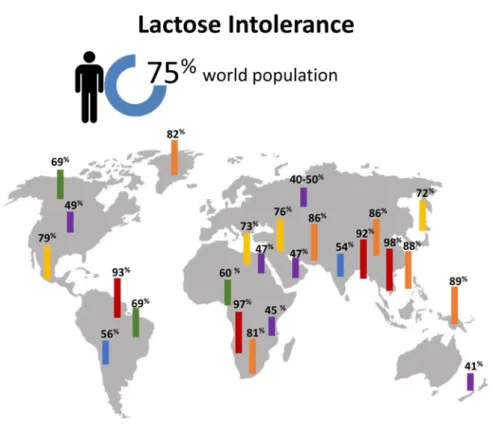
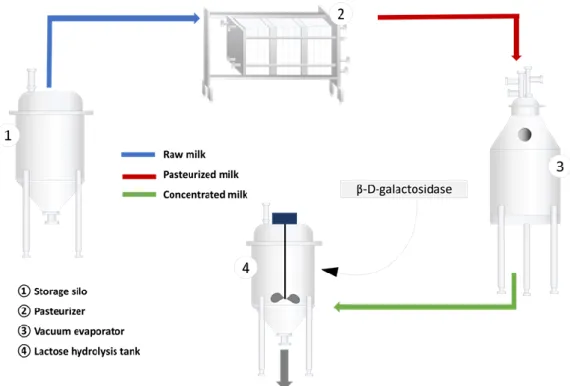

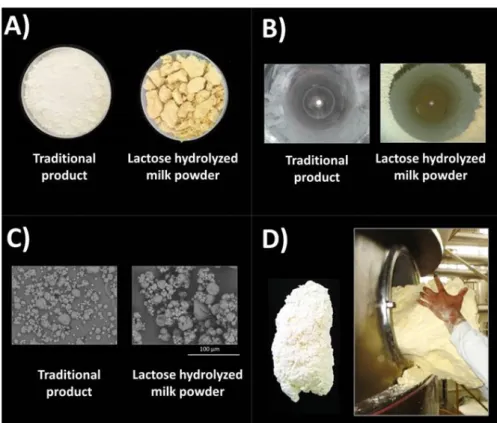
Documents relatifs
Proposez une nouvelle hypothèse et une solution pratique pour la tester : quoi, comment et avec quoi ; pour quels résultats. Partie 3 :
• Au niveau du colon par les bactéries de la flore intestinale grâce à une enzyme, la ß galactosidase qui réalise elle aussi l’hydrolyse du lactose?. Mais au niveau du colon,
Das Ziel der Probenvorbereitung ist die vollständige Freisetzung des Wassers in das Lösungsmittel [DeCaro, 2001]. Die Semesterarbeit hat gezeigt, dass die Probevorbereitung
39: Danger of very serious irreversible effects 40: Limited evidence of a carcinogenic effect 41: Risk of serious damage to eyes 42: May cause sensitization by inhalation 43:
La cellule peut utiliser le lactose comme source d'énergie en produisant l'enzyme β-galactosidase (LacZ) et ainsi transformer le lactose en glucose et en galactose..
Taken together, these results provide new in- formation in milk composition from young undernourished rat mothers (60 days old). Although milk production was not directly measured
La cellule peut utiliser le lactose comme source d'énergie en produisant l'enzyme β-galactosidase (LacZ) et ainsi transformer le lactose en glucose et en galactose.. Toutefois,
Le promoteur de l’opéron lactose permet la fixation de l'ARN polymérase mais aussi la fixation d’un répresseur empêchant la transcription de l’opéron par l'ARN polymérase..
